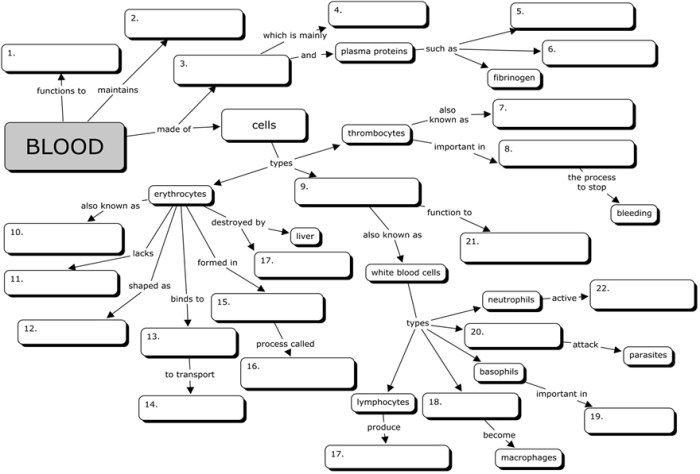Blood concept map biology corner – Embarking on a journey through the intricacies of blood biology, this comprehensive guide, titled “Blood Concept Map: A Comprehensive Guide to Blood Biology,” unravels the fundamental components, circulatory mechanisms, and diagnostic significance of blood. Prepare to delve into the fascinating world of hematology, where the life-sustaining fluid that courses through our veins holds the key to understanding health and disease.
Blood Components
Blood is a complex fluid that plays a vital role in maintaining homeostasis in the body. It is composed of various components, each with specific functions:
- Red blood cells: Carry oxygen from the lungs to the tissues.
- White blood cells: Defend the body against infections and foreign substances.
- Platelets: Aid in blood clotting to prevent excessive bleeding.
- Plasma: Liquid component that contains dissolved substances, such as nutrients, hormones, and waste products.
These components work together to maintain blood volume, transport nutrients and oxygen, remove waste products, and protect against infection and bleeding.
Blood Circulation: Blood Concept Map Biology Corner

The circulatory system consists of the heart, blood vessels, and blood. Blood flows through the body in a continuous loop, starting from the heart and returning to the heart:
- Heart: Pumps blood through the body.
- Arteries: Carry blood away from the heart to the tissues.
- Capillaries: Tiny vessels where gas and nutrient exchange occurs between the blood and tissues.
- Veins: Carry blood back to the heart from the tissues.
Blood pressure, the force exerted by blood on the blood vessel walls, is essential for maintaining circulation.
Blood Clotting

Blood clotting is a process that prevents excessive bleeding when blood vessels are damaged. It involves a series of steps:
- Platelet activation: Platelets stick to the damaged blood vessel.
- Formation of a platelet plug: Platelets aggregate and form a temporary plug.
- Coagulation cascade: A series of biochemical reactions that lead to the formation of fibrin, a protein that forms a stable clot.
Blood clotting is crucial for preventing excessive blood loss and maintaining homeostasis.
Blood Disorders
Blood disorders can affect any component of blood or the circulatory system, leading to a variety of symptoms and health issues:
- Anemia: Reduced red blood cell count or hemoglobin levels.
- Leukemia: Cancer of the white blood cells.
- Thrombocytopenia: Low platelet count.
- Hemophilia: Genetic disorder that impairs blood clotting.
Treatment for blood disorders depends on the specific condition and may include medications, blood transfusions, or surgery.
Blood Transfusions
Blood transfusions involve transferring blood or blood components from one individual (donor) to another (recipient). They are used to:
- Replace lost blood after trauma or surgery.
- Treat blood disorders.
- Support patients with organ failure.
Blood transfusions are safe and effective, but they require careful matching of blood types to prevent immune reactions.
Blood as a Diagnostic Tool
Blood tests are widely used to diagnose and monitor various medical conditions. They involve analyzing different components of blood:
- Complete blood count: Measures the number and types of blood cells.
- Chemistry panel: Measures levels of electrolytes, enzymes, and other substances in the blood.
- Coagulation tests: Assess blood clotting ability.
Blood tests provide valuable information about overall health, organ function, and disease status.
Query Resolution
What are the main components of blood?
Blood comprises red blood cells, white blood cells, platelets, and plasma, each playing distinct roles in maintaining homeostasis.
How does blood circulate through the body?
Blood flows through a network of blood vessels, including arteries, capillaries, and veins, propelled by the pumping action of the heart.
What is the significance of blood clotting?
Blood clotting is a crucial process that prevents excessive bleeding by forming a protective barrier at the site of injury.